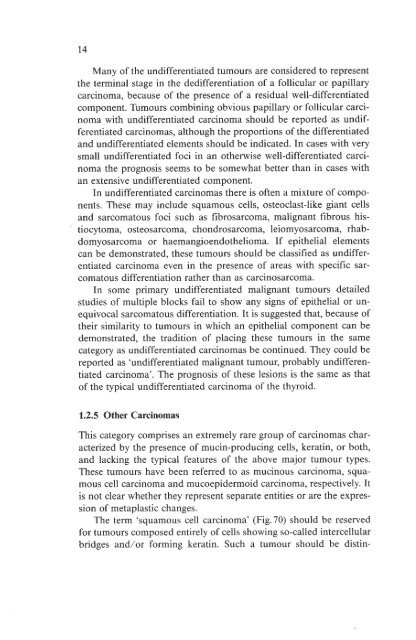Histological Typing of Thyroid Tumours - libdoc.who.int - World ...
Histological Typing of Thyroid Tumours - libdoc.who.int - World ...
Histological Typing of Thyroid Tumours - libdoc.who.int - World ...
You also want an ePaper? Increase the reach of your titles
YUMPU automatically turns print PDFs into web optimized ePapers that Google loves.
74<br />
Many <strong>of</strong> the undifferentiated tumours are considered to represent<br />
the terminal stage in the dedifferentiation <strong>of</strong> a follicular or papillary<br />
carcinoma, because <strong>of</strong> the presence <strong>of</strong> a residual well-differentiated<br />
component. <strong>Tumours</strong> combining obvious papillary or follicular carcinoma<br />
with undifferentiated carcinoma should be reported as undifferentiated<br />
carcinomas, although the proportions <strong>of</strong> the differentiated<br />
and undifferentiated elements should be indicated. In cases with very<br />
small undifferentiated foci in an otherwise well-differentiated carcinoma<br />
the prognosis seems to be somewhat better than in cases with<br />
an extensive undifferentiated component.<br />
In undifferentiated carcinomas there is <strong>of</strong>ten a mixture <strong>of</strong> components.<br />
These may include squamous cells, osteoclast-like giant cells<br />
and sarcomatous foci such as fibrosarcoma, malignant hbrous histiocytoma,<br />
osteosarcoma, chondrosarcoma, leiomyosarcoma, rhabdomyosarcoma<br />
or haemangioendothelioma. If epithelial elements<br />
can be demonstrated, these tumours should be classified as undifferentiated<br />
carcinoma even in the presence <strong>of</strong> areas with specific sarcomatous<br />
differentiation rather than as carcinosarcoma.<br />
In some primary undifferentiated malignant tumours detailed<br />
studies <strong>of</strong> multiple blocks fail to show any signs <strong>of</strong> epithelial or unequivocal<br />
sarcomatous differentiation. It is suggested that, because <strong>of</strong><br />
their similarity to tumours in which an epithelial component can be<br />
demonstrated, the tradition <strong>of</strong> placing these tumours in the same<br />
category as undifferentiated carcinomas be continued. They could be<br />
reported as'undifferentiated malignant tumour, probably undifferentiated<br />
carcinoma'. The prognosis <strong>of</strong> these lesions is the same as that<br />
<strong>of</strong> the typical undifferentiated carcinoma <strong>of</strong> the thyroid.<br />
1.2.5 Other Carcinomas<br />
This category comprises an extremely rare group <strong>of</strong> carcinomas characteized<br />
by the presence <strong>of</strong> mucin-producing cells, keratin, or both,<br />
and lacking the typical features <strong>of</strong> the above major tumour types.<br />
These tumours have been referred to as mucinous carcinoma, squamous<br />
cell carcinoma and mucoepidermoid carcinoma, respectively. It<br />
is not clear whether they represent separate entities or are the expression<br />
<strong>of</strong> metaplastic changes.<br />
The term 'squamous cell carcinoma' (Fig.70) should be reserved<br />
for tumours composed entirely <strong>of</strong> cells showing so-called <strong>int</strong>ercellular<br />
bridses and/or formine keratin. Such a tumour should be distin-
















